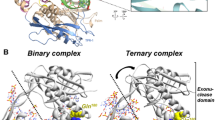Abstract
Effects of the antibiotic novobiocin on the self-splicing of primary transcripts of the phage T4 thymidylate synthase gene (td) have been investigated. Novobiocin at 10 mM concentration inhibited the splicing by about 5% but at 40 mM concentration the splicing rate was inhibited by about 50%. The novobiocin inhibition of the self-splicing reaction was not reversed even at a high concentration (200 μM) of guanosine. However, increasing the Mg2+ ion concentrations up to 20 mM almost fully restored the splicing activity to the normal splicing level. The double reciprocal plot analysis demonstrated that novobiocin acts as a mixed noncompetitive inhibitor for the td intron RNA with a K i of 90 mM. The splicing inhibition by novobiocin was strongly dependent on Mg2+ ion concentration, indicating electrostatic interactions with the td intron RNA. It is likely that the antibiotic novobiocin may interfere with the catalytic actions of Mg2+ ion in the splicing reaction of the td intron RNA.






Similar content being viewed by others
References
Chu FK, Maley GF, Maley F, Belfort M (1984) Intervening sequence in the thymidylate synthase gene of bacteriophage T4. Proc Natl Acad Sci USA 81:3049–3053
Cech TR, Tanner NK, Tinoco I Jr, Weir BR, Zuker M, Perlman PS (1983) Secondary structure of the Tetrahymena ribosomal RNA intervening sequence. Proc Natl Acad Sci USA 80:3903–3907
Chu FK, Maley GF, West DK, Belfort M, Maley F (1986) Characterization of the intron in the phage T4 thymidylate synthase gene and evidence for its self-excision from the primary transcript. Cell 45:157–166
Bass B, Cech TR (1986) Deoxyguanosine and dideoxyguanosine are competitive inhibitors of self-splicing of the Tetrahymena ribosomal RNA precursor. Biochemistry 25:4473–4477
Yarus M (1988) A specific amino acid binding site composed of RNA. Science 240:1751–1758
von Ahsen U, Schroeder R (1991) Streptomycin inhibits splicing of group 1 introns by competition with the guanosine substrate. Nucleic Acids Res 19:2261–2265
Wank H, Rogers J, Davies J, Schroeder R (1994) Peptide antibiotics of the tuberactinomycin family as inhibitors of group 1 intron splicing. J Mol Biol 236:1001–1010
Kim JY, Park IK (2000) The flavin coenzymes: a new class of group 1 intron inhibitors. Biochim Biophys Acta 1475:56–61
Ahn SJ, Park IK (2003) The coenzyme thiamine pyrophosphate inhibits the self-splicing of the group 1 intron RNA. Int J Biochem Cell Biol 35:157–167
Rogers J, Davies J (1994) The pseudodisaccharides: a novel class group 1 intron splicing inhibitors. Nucleic Acids Res 24:4983–4988
von Ahsen U, Davies J, Schroeder R (1991) Antibiotic inhibition of group 1 ribozyme function. Nature 353:368–370
Liu Y, Tidwell RR, Leibowitz MJ (1994) Inhibition of in vitro splicing of group 1 intron of Pneumocystis carnii. J Eukaryot Microbiol 41:31–38
Park IK, Lim EH, Shin S (2000) Spectinomycin inhibits the self-splicing of group 1 intron RNA. Biochem Biophys Res Commun 269:574–579
Park IK, Sung JS (2000) K+ and Mg2+ ions promote the self-splicing of the td intron RNA inhibited by spectinomycin. Biochim Biophys Acta 1492:94–99
Hoch I, Berens C, Westhof E, Schroeder R (1998) Antibiotic inhibition of RNA catalysis: neomycin B binds to the catalytic core of the td group 1 intron displacing essential metal ions. J Mol Biol 282:557–569
Maxwell A, Lawson DM (2003) The ATP-binding site of type II topoisomerases as a target for antibacterial drugs. Curr Top Med Chem 3:282–303
Luhrmann A, Tholke J, Behn I, Schumann J, Tiegs G, Hauschildt S (1998) Immunodulatin properties of the antibiotic novobiocin in human monocytes. Antimicorb Agents Chemother 42:1911–1916
Shin S, Park IK (1993) The functional importance of an internal guide sequence in the T4 td intron in RNA splicing. J Biochem Mol Biol 26:614–619
Puglisi JD, Tinoco I Jr (1989) Absorbance melting curves of RNA. Methods Enzymol 180:304–325
Cech TR (1987) The chemistry of self-splicing RNA and RNA enzyme. Science 236:1532–1539
Pyle AM (1993) Ribozymes: a distinct class of metalloenzymes. Science 261:709–714
McConnell TS, Herschlalg D, Cech TR (1997) Effects of divalent metal cations on individual steps of the Tetrahymena ribozyme reaction. Biochemistry 36:8293–8303
von Ahsen U, Davies J, Schroeder R (1992) Noncompetitive inhibition of group 1 intron RNA self-splicing by aminoglycoside antibiotics. J Mol Biol 226:935–941
Grosshans CA, Cech TR (1989) Metal ion requirements for sequence-specific endonuclease activity of the Tetrahymena ribozyme. Biochemistry 28:6888–6894
Celander DW, Cech TR (1991) Visualizing the higher order folding of a catalytic RNA molecule. Science 251:401–407
Acknowledgments
We sincerely thank Dr. Fred K. Chu for his generous gift of the pGEM recombinant plasmids, and Mr. Jung Mook Choi and Mr. Keun Soo Son for their assistance in the preparation of the manuscript.
Author information
Authors and Affiliations
Corresponding author
Rights and permissions
About this article
Cite this article
Jung, W.S., Shin, S. & Park, I.K. Novobiocin inhibits the self-splicing of the primary transcripts of T4 phage thymidylate synthase gene. Mol Cell Biochem 314, 143–149 (2008). https://doi.org/10.1007/s11010-008-9775-8
Received:
Accepted:
Published:
Issue Date:
DOI: https://doi.org/10.1007/s11010-008-9775-8




